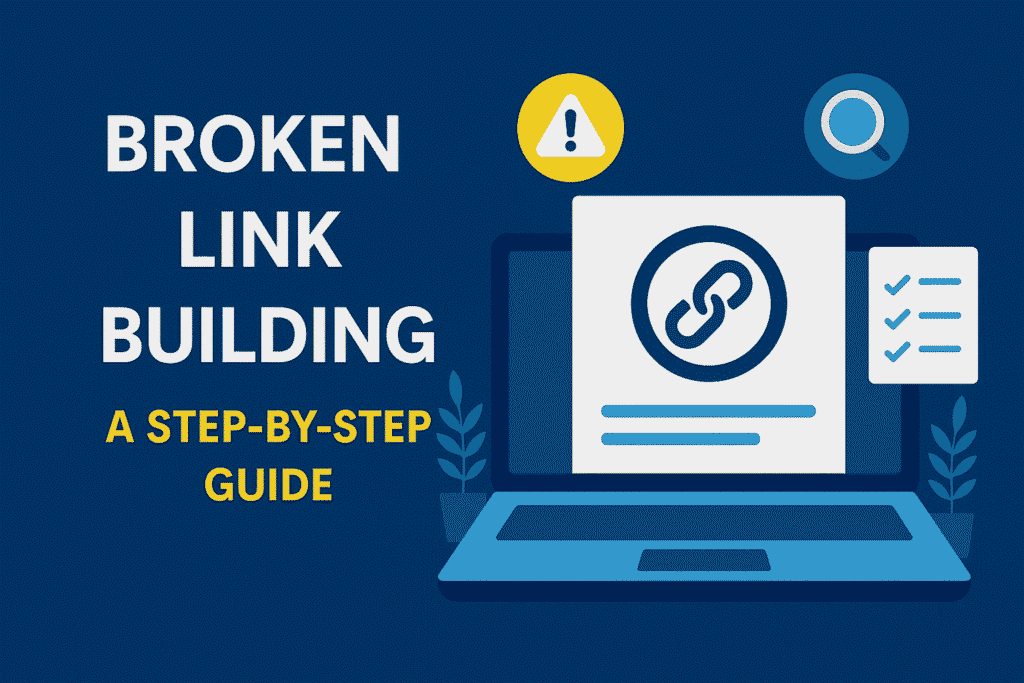
Contents
In the ever-evolving world of SEO, Linkbuilding remains one of the most critical ranking factors. However, earning high-quality backlinks can be challenging, especially with increasing competition. That’s where broken link building comes in—a white-hat SEO strategy that helps you build relationships, improve website authority, and drive referral traffic by replacing dead links with your own content.
If you’re unsure what link building is, read What is Link Building? first.
Unlike traditional link-building tactics (such as guest posting or directory submissions), broken link building is non-intrusive and mutually beneficial. Webmasters appreciate it because you’re helping them fix broken links on their sites, while you gain a valuable backlink in return.
In this step-by-step guide, you’ll learn:
- What broken link building is and why it works
- How to find broken link opportunities (manual & tool-based methods)
- How to craft the perfect outreach email
- Common mistakes to avoid
Whether you’re an SEO specialist, blogger, or digital marketer, this guide will help you leverage broken link building effectively.
Step 1: Understanding Broken Link Building
What Are Broken Links?
Broken links (or “dead links”) are hyperlinks that lead to 404 error pages because:
- The linked page was deleted or moved without a redirect.
- The domain expired or changed.
- The URL structure was modified (e.g., after a website migration).
Why Does Broken Link Building Work?
- Webmasters Want to Fix Errors – Broken links harm user experience (UX) and SEO.
- It’s a Win-Win Strategy – You provide value by suggesting a replacement, and they get a working link.
- Higher Success Rate – Unlike cold outreach, you’re solving a problem, making webmasters more likely to respond.
Step 2: Finding Broken Link Opportunities
A. Manual Search Method
1. Look for Resource Pages
Many websites have “Resources,” “Useful Links,” or “Recommended Tools” pages—ideal places to find broken links.
Google Search Operators to Find Resource Pages:
site:example.com inurl:links"your keyword" + "resources""best tools for [industry]"
2. Check Competitor Backlinks
Use Ahrefs or Moz to analyze competitors’ backlinks. Look for:
- Links pointing to old/deleted pages (potential broken links).
- Resource pages linking to multiple external sites.
B. Using SEO Tools to Find Broken Links
1. Ahrefs (Broken Links Report)
- Go to Site Explorer > enter competitor’s domain > Best by Links > Broken.
- Export the list and check for relevant broken links.
2. Check My Links (Chrome Extension)
- Instantly scans a webpage for dead links.
- Useful for auditing blogrolls and resource pages.
3. Screaming Frog SEO Spider
- Crawls a website and flags broken outbound links.
- Best for large-scale broken link discovery.
Step 3: Identifying High-Quality Replacement Content
Before reaching out, ensure your content is:
- Relevant – Matches the context of the broken link.
- Higher Quality – More detailed, updated, or better designed.
- Authoritative – Well-researched with credible sources.
Types of Content to Offer:
- Blog Posts (In-depth guides, tutorials)
- Tools & Resources (Free templates, calculators)
- Infographics & Visual Content
- Research Studies & Statistics
Pro Tip: If you don’t have a suitable replacement, consider creating one—this is a great content gap opportunity!
Step 4: Outreach Strategy (How to Get the Link)
A. Finding the Right Contact
- Hunter.io or VoilaNorbert – Finds email addresses from websites.
- LinkedIn/Twitter – Directly message the webmaster or content manager.
B. Crafting the Perfect Outreach Email
Subject Line:
“Quick Fix for a Broken Link on [Their Website]”
“404 Error on Your [Page Name] – Here’s a Replacement”
Email Template:
Hi [First Name],
*I was browsing your [resource page/article] and noticed a broken link under the “[Anchor Text]” section. It currently leads to a 404 page.*
Since your readers might find this frustrating, I wanted to suggest a replacement: [Your Content URL]. It covers [Topic] in detail and could be a great fit for your page.
Let me know if you’d like to update it! Either way, keep up the great work on [Their Website].
Best regards,
[Your Name]
Key Tips:
- Keep it short & personalized (mention their site/content).
- Don’t sound salesy—focus on helping them.
- Include the broken link & your suggested replacement.
Step 5: Following Up & Building Relationships
- Send a polite follow-up after 5-7 days if no response.
- Thank webmasters who update the link—this can lead to future collaborations.
- Track your success with a spreadsheet (Website, Contact, Status).
Common Mistakes to Avoid
- Replacing Links with Irrelevant Content – Only suggest highly relevant replacements.
- Spamming Webmasters – Personalize each email.
- Skipping Follow-Ups – Many webmasters miss the first email.
- Not Checking Link Quality – Ensure the linking page has decent traffic & authority.
Conclusion: Start Building Links the Smart Way
Broken link building is one of the most ethical and effective ways to earn backlinks. By helping webmasters fix errors, you build authority, improve SEO, and create valuable connections. This method is one of the tactics mentioned in The Best Link Building Strategies That Actually Work in 2025.
Ready to Get Started?
- Find 5-10 broken link opportunities using Ahrefs or manual searches.
- Craft personalized outreach emails.
- Track responses and refine your approach.
Pro Tip: Combine this with guest posting and skyscraper techniques for even better results!
Want a Done-For-You Broken Link Building Strategy? Contact us with our Linkbuilding team today!
